Topics
Category
Era
Sixth Minnesota Volunteer Infantry Regiment
The Women of St. Paul presented this patriotic silk flag to the members of the Sixth Minnesota's Company G on October 23, 1862.
The Sixth Minnesota Volunteer Infantry performed crucial frontier service during the U.S.–Dakota War of 1862 and into 1863. Their first experience in the South involved horrible attrition due to disease. Yet the regiment held together, and they took part in one of the final Southern campaigns in 1865.
The Sixth Minnesota Volunteer Infantry was organized throughout the summer and fall of 1862 in response to President Abraham Lincoln's July and August calls for a total of 600,000 additional troops. It was originally intended that the regiment would be sent south as soon as it was full. However, the outbreak of the U.S.-Dakota War in August 1862 would keep the regiment close to home for the next two years. In the end, five companies of the Sixth Minnesota took part in fighting against the Dakota under the direction of Colonel William Crooks of Ramsey.
On August 31 Company A of the Sixth Minnesota, along with a company of mounted rangers, was sent from Fort Ridgley to the Lower Sioux Agency on burial detail. They were also trying to learn more about the August 18 ambush of a group of Fifth Minnesota Infantry troops under Captain John Marsh. They buried about fifty bodies the first day. The next day they discovered the bodies of Captain Marsh and his men. They made camp that evening at Birch Coulee in Renville County. On the morning of September 2 the men were attacked by a few hundred Dakota fighters. The members of the Sixth held out until the following morning, when two separate relief columns, including some artillery, came from Ft. Ridgley. They forced Taoyateduta (Little Crow IV)'s men to retire. The soldiers who had camped at Birch Coulee lost twenty-three killed and mortally wounded and forty-five severely wounded. This was the highest loss for U.S. troops in the 1862 U.S.-Dakota War.
On September 23 the Sixth fought in the Battle of Wood Lake. This victory for the U.S. forces ended the U.S.-Dakota War. Following this battle, the regiment spent the winter of 1862–1863 on frontier duty. The next summer, the Sixth took part in Sibley's successful 1863 campaign against the Dakota. The troops pushed the Dakota all the way to and across the Missouri River.
The regiment then returned to garrison duty. In November and December 1863 Companies D, E and H escorted supplies to the displaced Dakota and Winnebago along the Missouri River in Dakota Territory. The treacherous winter conditions led to the troops' calling this foray the "Moscow Expedition."
By the spring of 1864 the members of the Sixth Minnesota were very frustrated that they had not yet been sent south. Unfortunately, when orders eventually came to move, the men were directed to proceed to Helena, Arkansas, on the Mississippi River. Colonel Crooks's protests and attempts to change the regiment's orders were to no avail.
The Sixth, 950-men strong, arrived in Helena on June 23, 1864, and spent the next four months in what Private Charles W. Johnson of Company D called "a series of swamps, bayous and flat lands, overflowed from the Mississippi in high water, reeking with miasma and covered with green scum in dry weather." By the end of October, two officers and fifty-eight enlisted men had died from disease, most from malaria. On September 30, 654 members of the Sixth were reported as sick, with only 140 men reporting for duty. By now, 461 men had been sent to hospitals in the North. The situation was so severe that Dr. Levi Butler, a commissioner appointed by the state to report on the condition of troops in the field, admitted in a letter that he did not want to report the true condition of the regiment to the public.
Finally in November the regiment was moved to St. Louis, then to New Orleans in late January 1865. In March and April of that year the Sixth took part in General E.R.S. Canby's campaign against Mobile, Alabama, and was in reserve during the April 9 capture of Fort Blakely. The Sixth Minnesota had fought the Confederates at last. The regiment was moved to Montgomery, Alabama, and eventually back home. They mustered out at Fort Snelling on August 19, 1865.
Bibliography
Board of Commissioners. Minnesota in the Civil and Indian Wars, 1861-1865. 2 vols. St. Paul: The Pioneer Press Company, 1891.
http://archive.org/details/minnesotacivil01minnrich
Dyer, Frederick H. A Compendium of the War of the Rebellion. Des Moines: The Dyer Publishing Company, 1908.
http://archive.org/details/08697590.3359.emory.edu
Hill, Alfred J. History of Company E of the Sixth Minnesota Regiment of Volunteer Infantry. St. Paul: Pioneer Press Co., 1899.
United States War Department. The War of the Rebellion: A Compilation of the Official Records of the Union and Confederate Armies. 70 vols. in 128 parts. Washington, D.C.: Government Printing Office, 1880-1901. Reprint: Harrisburg: National Historical Society, 1971. (Series 1, vol. 49, part 1.)
http://archive.org/details/warrebellionaco17offigoog
Related Resources
Primary
A/-W876
John Kingsley Wood Diary, 1855–1865
Manuscript Collection, Minnesota Historical Society, St. Paul.
Description: Diary of a member of Company F of the Sixth Minnesota, recounting mainly campaigns against the Dakota, as well as some experiences in the South late in the war.
Secondary
Longfellow, Grace M., Comp. Scrapbook of the Sixth Minnesota Volunteer Infantry. 1891–1944.
Veterans' Association. The 19th Annual Reunion Sixth Minnesota Regiment. St. Paul: Sixth Minnesota Veterans' Association, 1910.
Related Images
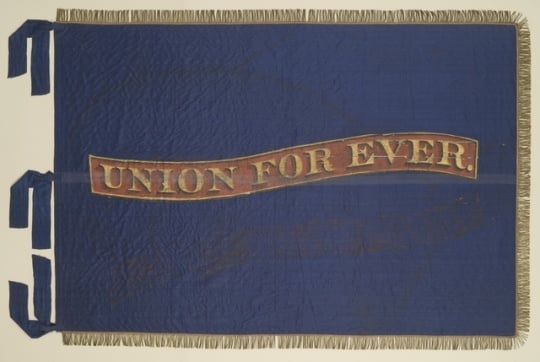
Sixth Minnesota company flag
The Women of St. Paul presented this patriotic silk flag to the members of the Sixth Minnesota's Company G on October 23, 1862.
All rights reserved
Holding Location
More Information
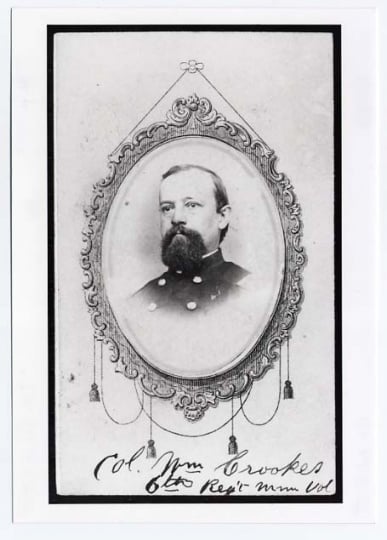
William Crooks, Colonel, Sixth Minnesota Infantry
William Crooks, Colonel, Sixth Minnesota Infantry, 1862–1864.
Holding Location
More Information
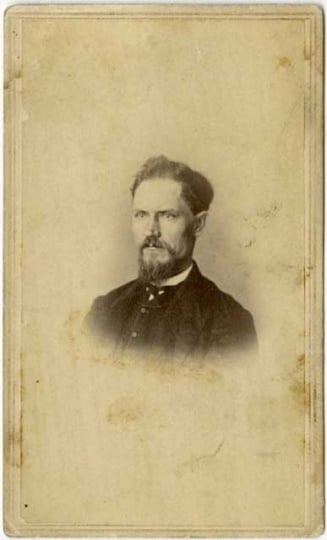
Orlando Crosby Merriman, Sr.
Orlando Crosby Merriman, Sr. Mayor of St. Anthony and Captain of Company B, Sixth Minnesota Regiment, c.1863. Photograph by Beal's Gallery.
Public domain
Holding Location
More Information
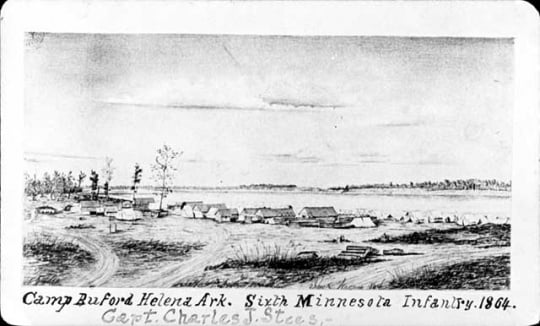
Camp Buford, Helena, Arkansas Sixth Minnesota Infantry
Camp Buford, Helena, Arkansas, 1864. The Sixth spent four and a half months garrisoning Helena, during which time many men died or fell ill from disease.
Public domain
Holding Location
More Information
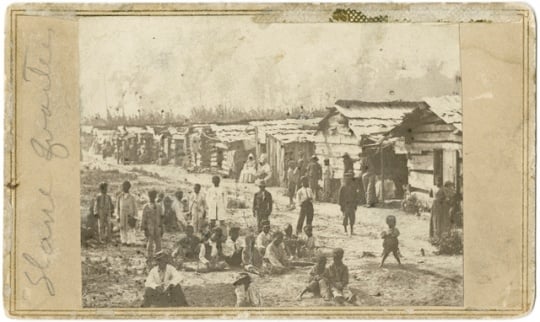
Enslaved people and their homes, Helena, Arkansas
Enslaved people and their homes, Helena, Arkansas, 1864. This photograph was taken while Sixth Minnesota Volunteers were camped in Helena. Photograph by T. W. Bankes.
Public domain
Holding Location
More Information
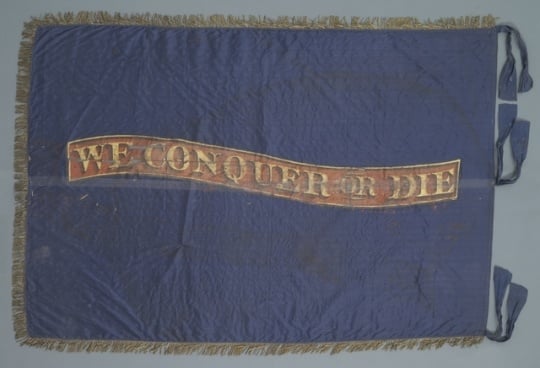
Sixth Minnesota company flag
Flag of Company G of the Sixth Minnesota Infantry is made of blue silk, with the motto "Union Forever" on the obverse and "Conquor or Die" on reverse. It was presented by women of St. Paul to Company G on October 23, 1862.
All rights reserved
Holding Location
More Information
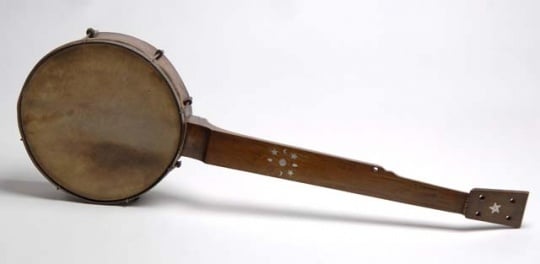
Five-string banjo (stringless)
Banjo made by Franklin Tenney Brawley, a drummer in the Sixth Minnesota Volunteer Infantry Regiment, Company G. Brawley made the banjo during the 1862 U.S.-Dakota War from a bed post and a drum head. The Banjo is inlaid with silver coins and features a hand drawn U.S.A. shield and flag.
All rights reserved
Holding Location
More Information
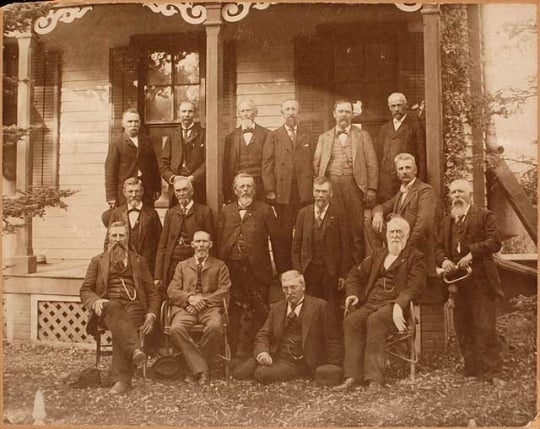
Survivors members of Company F, Sixth Minnesota Volunteer Infantry at the home of Captain Horace B. Wilson at Red Wing
Members of Company F, Sixth Minnesota Volunteer Infantry at the home of Captain Horace B. Wilson at Red Wing, 1897.
Public domain
Holding Location
More Information
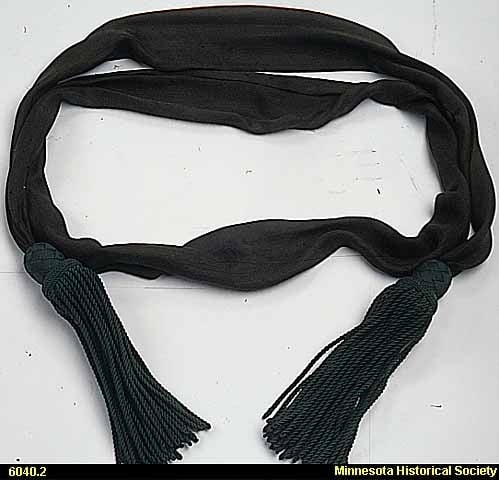
US Army medical officer's uniform sash
Dark green knit silk uniform sash worn during the Civil War by Chief Surgeon Alfred Wharton of the Sixth Minnesota Regiment. Wharton resigned in 1864 due to illness contracted while at Helena, Arkansas.
All rights reserved
Holding Location
More Information
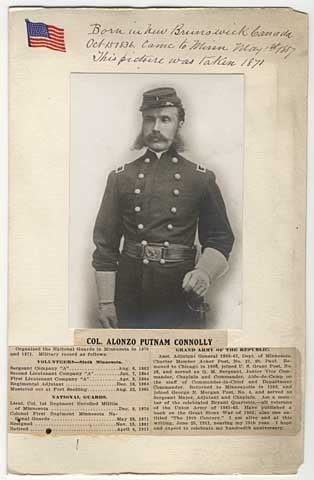
Colonel Alonzo Putnam Connolly, Sixth Minnesota Volunteer Infantry and National Guards
Colonel Alonzo P. Connolly, who was adjutant of the Sixth Minnesota Volunteer Infantry during the Civil War 1871.
Public domain
Holding Location
More Information

US Army officer's Model 1850 sword
Detail of sword used during the Civil War by Adjutant Alonzo Putnam Connolly of the Sixth Minnesota Volunteer Infantry. Tiffany and Company made the hilt and did the etching on the blade.
All rights reserved
Holding Location
More Information
Related Articles
Turning Point
June–November 1864: The Sixth Minnesota garrisons Helena, Arkansas, during which time hundreds become ill and several die of disease.
Chronology
Summer-Fall 1862
September 1-3, 1862
September 23, 1862
Winter 1862-63
Summer 1863
November-December 1863
Winter 1863-spring 1864
June 9, 1864
June 1864
June 23–November 4, 1864
November 1864-January 1865
March-April 1865
April 9, 1865
August 19, 1865
Bibliography
Board of Commissioners. Minnesota in the Civil and Indian Wars, 1861-1865. 2 vols. St. Paul: The Pioneer Press Company, 1891.
http://archive.org/details/minnesotacivil01minnrich
Dyer, Frederick H. A Compendium of the War of the Rebellion. Des Moines: The Dyer Publishing Company, 1908.
http://archive.org/details/08697590.3359.emory.edu
Hill, Alfred J. History of Company E of the Sixth Minnesota Regiment of Volunteer Infantry. St. Paul: Pioneer Press Co., 1899.
United States War Department. The War of the Rebellion: A Compilation of the Official Records of the Union and Confederate Armies. 70 vols. in 128 parts. Washington, D.C.: Government Printing Office, 1880-1901. Reprint: Harrisburg: National Historical Society, 1971. (Series 1, vol. 49, part 1.)
http://archive.org/details/warrebellionaco17offigoog
Related Resources
Primary
A/-W876
John Kingsley Wood Diary, 1855–1865
Manuscript Collection, Minnesota Historical Society, St. Paul.
Description: Diary of a member of Company F of the Sixth Minnesota, recounting mainly campaigns against the Dakota, as well as some experiences in the South late in the war.
Secondary
Longfellow, Grace M., Comp. Scrapbook of the Sixth Minnesota Volunteer Infantry. 1891–1944.
Veterans' Association. The 19th Annual Reunion Sixth Minnesota Regiment. St. Paul: Sixth Minnesota Veterans' Association, 1910.












